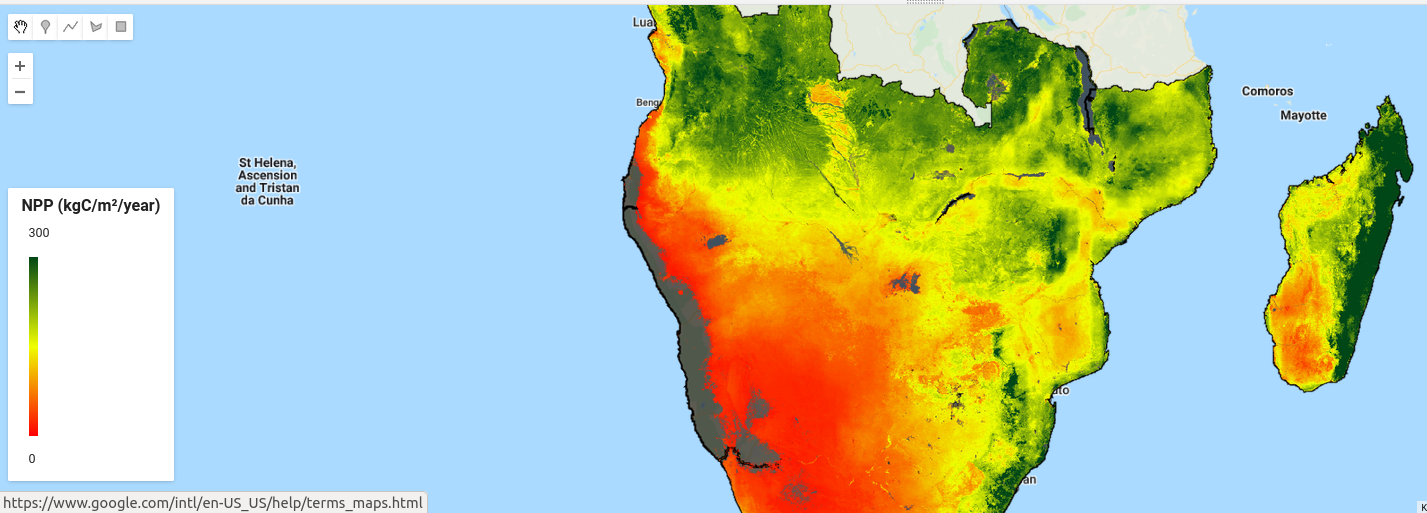Introduction
Net primary productivity (NPP) is the net amount of carbon absorbed after photosynthesis and respiration over a given period (represented in kg/ha/year units). Climate change scientists use NPP to evaluate the global carbon balance and ecosystems. NPP distribution is critical to understanding vegetation dynamics in biomes, biodiversity, potential agricultural yield, and predicting global climate changes. Scientists and researchers report that ecosystem services (provisional, regulative, supporting, and cultural) positively correlate with NPP.
Earth Observation (EO) systems have considerable potential to measure and monitor ecosystem services. To date, scientists and researchers derive NPP from EO data to assess changes in the capacity of ecosystems to supply services. For example, remote sensing researchers use the Moderate Resolution Imaging Spectroradiometer (MODIS MOD17A3) data to estimate NPP. The MODIS (MOD17A3) data provides quality globally validated modeled NPP estimates (available for free).
Challenges and Limitations of EO Data
Although EO sensors such as MODIS provide essential data, they often need to be combined with field measurements to represent the desired ecosystem function accurately. However, many countries in tropical regions still face the challenge of processing EO data into valuable products. In addition, cost-effective methods to understand the factors controlling ecosystem productivity are still limited in these regions, given the lack of field data, which is expensive to collect. For example, NPP calculation depends on the land-cover data from which biome-specific parameters are used to model NPP. However, the land cover data is generally assumed to be accurate, which is not always true.
Opportunities and Way forward
The increased capacity in field data collection and the integrated use of multiple EO data sets can help overcome some of these challenges. However, scientists and policy-makers need to identify the needs, data, and product requirements. In addition, there is also a need to prioritize the setting of super test (field) sites in tropical regions and new satellite missions. These missions could provide more opportunities to expand ecosystem monitoring capacity, especially concerning NPP modeling.
Beyond new satellite missions, advances in data processing using machine learning or deep learning provide more opportunities. In addition, image fusion techniques such as combining high and low spatial resolution imagery are essential. For example, the combination of Sentinel-2 and MODIS data into time series with high spatial and temporal resolution could support a better characterization of NPP in different ecosystems. In addition, global LiDAR data from space-borne missions such as GEDI can be integrated with MODIS data to monitor biomass and NPP.
Last but not least international organizations and corporations are also transforming EO data into helpful information and services. For example, NASA/USGS and European Space Agency (ESA) are providing opportunities to use free EO data sets. In addition, the availability of analysis-ready EO data, coupled with cloud infrastructure and open-source software, is also creating more opportunities. For example, Google, Microsoft, FAO, and Digital Earth Africa provide platforms to analyze EO data into new information products. As a result, scientists, policy-makers, the private sector, and civil society can access helpful insights to address climate change challenges.
Next Steps
This blog post will use the Terra/MODIS product (MOD17A3). We will examine primary productivity estimates in Google Earth Engine (GEE) for selected Southern African countries (Angola, Botswana, Lesotho, Malawi, Mozambique, Madagascar, Namibia, South Africa, Eswatini (Swaziland), Zambia, and Zimbabwe). Readers can access the GEE app and script (click the links).
AI.Geolabs is also looking for partners (from universities, research institutes, and private companies) to formulate projects for monitoring NPP. Interested people can contact me at cou.kamusoko@aigeolabs.com.


